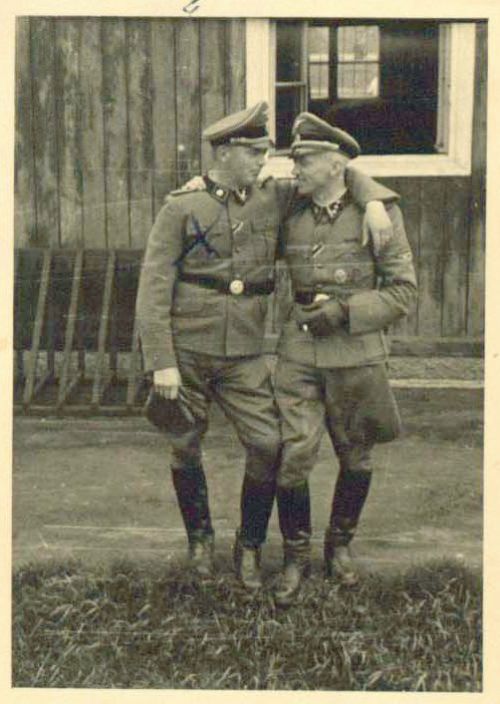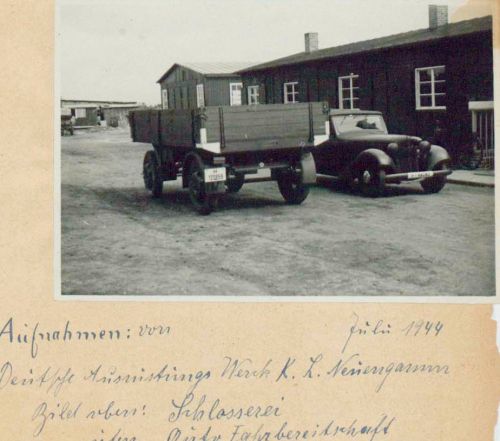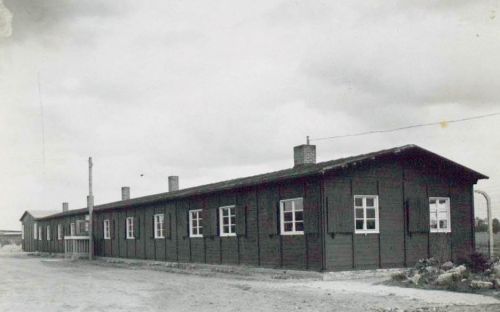Neuengamme

SS Officers in Neuengamme
Initially Neuengamme was an annex of the Sachsenhausen Concentration Camp situated on the outskirts of the major German city of Hamburg. The first group of prisoners arrived at Neuengamme on December 13, 1938, engaged in the task of constructing the camp. The prisoners were housed in a disused brick factory, this factory's very existence was the reason for the establishment of a concentration camp in Hamburg, which at the time had only temporary, small camps - Wittmoor and Fuhlsbuttel, the SS wanted to reactivate the brick factory and use its products primarily in the major public structures that were being planned for the city.
During April 1940, the Deutsche-Erd und Steinwerke (German Earth and Stone Works Ltd), an SS economic enterprise, signed an agreement with the City of Hamburg that provided for a substantial expansion of the brick factory, the digging of a canal to connect the factory with a tributary of the River Elbe, and a siding linking it to the railway network. The work was to be completed by prisoners, barracks were put up and more prisoners were brought in, reaching approximately one thousand. As of June 4, 1940, Neuengamme became an independent concentration camp.
Beginning in the autumn of 1941, thousands of Soviet Prisoners-of -War were brought to Neuengamme, and it is interesting to note that Soviet nationals eventually became the largest national group in the camp, numbering some 34,500, which included 5,900 female prisoners.
During 1942, a number of private firms such as the well-known Walther weapons factory established branches at Neuengamme. Numerous annexes to the camp were set up at various centres of the armaments industry, especially the Bremen and Hamburg shipbuilding and machine works. They were also established in Hannover and in the industrial area of Brunswick, which adjoined the Volkswagen Company (the present site at Wolfsburg, and the Hermann Goring Works.
Neuengamme became a centre for scientific medical research and the most important medical research carried out in the camp focused on tuberculosis experiments. This research came about because of a tragic incident in the city of Lubeck, three years before Hitler came to power. In the laboratory of the municipal hospital three researchers sifted the BCG vaccine for use with infants in the children's clinic. After the vaccine was administered orally three times to 251 infants, it was discovered that it was contaminated with the virulent Koch bacillus. Seventy-three of the babies died. This incident almost halted the use of the BCG vaccine for several years, even though it was the most effective method, known at the time, for the prevention of tuberculosis.
Fourteen years later at Neuengamme, Nazi physicians repeated the 'Lubeck tragedy' by experimenting with little children. During 1944, the SS brought a transport from Auschwitz concentration camp to Neuengamme containing twenty-five children between six and twelve years of age. A Dr. Kurt Heissmeyer, in Berlin, had previously selected those children for experiments for 'the benefits of progress in medicine.' The camp doctors placed the children in an isolated block, under the care of prisoner professors and Dutch orderlies. All the children, thus isolated, showed evidence of tuberculosis.
The researchers started the medical experiments three weeks after the arrival of the children. The projects originator Dr Heissmeyer came from Berlin every ten days to work with the children. He made incisions in the skin and rubbed cultures of the tubercular bacilli into the skin of the left or right arm. After a few days, redness and swelling appeared on the arm and the auxiliary glands enlarged; the child's temperature rose sharply for a few days and then returned to normal in a week. The process was repeated several times. After administering a local anaesthetic, such as novocaine, a doctor made a long incision under the armpit to remove the lymphatic nodes of each child, in an operation that lasted about fifteen minutes. He then plugged and dressed the wound and sent the sterile test tubes, numbered and named to Berlin. In Berlin, technicians bred new cultures of tubercular bacilli, made an emulsion and sent the mixture back to the camp.
Every two weeks each child was given an injection of the vaccine from his own lymphatic node. After four or five months the majority of the children ran high temperatures. In the third month enlarged lymph nodes appeared in eighty per cent of the children. The doctors noted serious lung changes by the fourth month. By the six month stage cavities had formed in the lungs of almost every child. In April 1945, when the Allied forces were nearly at the gates of Neuengamme, Dr. Heissmeyer proposed that the children should be transferred to a sub-camp of Neuengamme, the Bullenhuser Damm school. He wanted all traces of the experiment eliminated, including the children. The children were taken to the basement. SS -physician Alfred Trzebinski administed morphine on the night of April 20, 1945, to twenty Jewish children. Four Jewish adult carers and six Red Army prisoners were also murdered in the basement of the school. The executions were overseen by SS-Officer Arnold Strippel. After being injected the children had ropes placed around their necks and were hanged. One of those present observed it was 'like pictures hung up a wall on hooks.'
Returning to 1944, during the summer large transports of Jewish prisoners were sent to the camp, mostly from Hungary and Poland. Some 13,000 Jewish prisoners passed through the main camp and its sub-camps, among this number was some 3,000 Jewish women during 1944, and 1945, as camps in the east were evacuated.

SS Officers at Neuengamme
Neuengamme had two camp commandants, SS- Obersturmbannführer Martin Weiss served in this role from 1940, until 1942. He was succeeded in 1942, by SS- Obersturmbannführer Max Pauly, who was commandant from 1942, until 1945. A number of prominent SS personnel who were stationed at Neuengamme, also served at other concentration camps, and they include:
Richard Baer, who served at Auschwitz as Commandant, Walter Eisfeld, who served at Dachau and Buchenwald, Karl Hoecker, who served at Lublin, Auschwitz and Dora, Dr. Bruno Kitt, who served at Auschwitz, Dr. Fritz Klein, who also served at Auschwitz and Bergen-Belsen, Dr. Willi Schatz, who also served in Auschwitz, Vincenz Schoettl, who also served at Auschwitz and Dachau, Kuno Schramm, who also served at Dachau, Gross Rosen and Lublin, Arnold Strippel, who also served at Buchenwald and Lublin, Anton Thumann, who also served at Dachau, Lublin, Gross Rosen and Auschwitz, Dr. Alfred Trzebinski, who also served at Auschwitz and Lublin. Dr. Eduard Wirths, who was in charge of all medical personnel in Auschwitz, and who also served in Dachau, Dora, and Bergen-Belsen.
It is estimated that the total number of prisoners sent to Neuengamme was one hundred and six thousand. The mortality rate was very high, compared with other concentration camps situated in the Reich, and it estimated that some fifty-five thousand prisoners perished in Neuengamme and its sub-camps.
Photographs of Neuengamme




Sources
www. Holocaustresearchproject.org - online resource
French L. Maclean, The Camp Men, Schiffer Publishing Ltd 1991
All Photographs - National Archives Kew
© Holocaust Historical Society 2018

